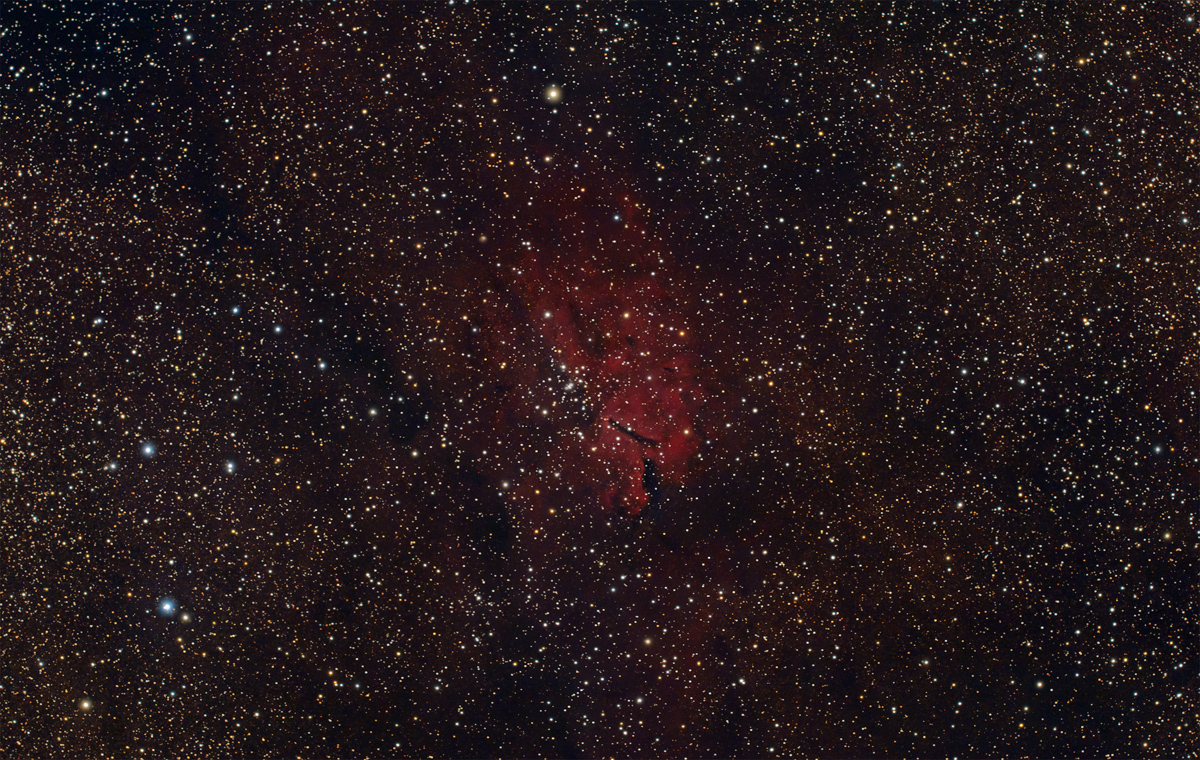
|
La nebulosa NGC 6820 nella Volpetta The NGC 6820 nebula in Vulpecula Center frame on A.R. 19h42m48s - Decl. 23°06'00" |
|
Questa foto della nebulosa NGC 6820 nella Volpetta è stata scattata nei giorni 11 e 13 agosto 2010 dal giardino di casa ad Arcidosso (GR) al fuoco diretto di un telescopio Takahashi TSA 102 ridotto a f/6.3 su montatura Gemini G41 Obs con FS2 L'esposizione è la somma di 20 frames da 10 minuti ciascuno ripresi con la Canon EOS 40D settata a 800 ISO e modificata con Filtro Baader IR-Cut, ed è stata effettuata con autoguida Atik 16IC e rifrattore 120/600 in parallelo. La temperatura esterna era fra 17° e 19° ma con un prototipo di cold box da me realizzato ho operato a temperature di circa 10° più basse costantemente. Successivamente i frames sono stati allineati calibrati con Deep Sky Stacker mediante l'uso di 31 dark, 21 flat, 21 dark dei flat e 21 bias, poi allineati e sommati con Registar. Dopo aver separato le stelle ho elaborato separatamente la nebulosa mediante applicazione di stretching, bilanciamento dei colori, riduzione del rumore e maschera sfocata selettiva. Successivamente le stelle sono state riunite alla foto elaborata. Nella tabella sottostante sono riportati i valori di temperatura, umidità e brillanza del cielo nella zona ripresa (usando lo SQM-L) a vari orari. This photo of the NGC 6820 nebula in Vulpecula, was taken on august 11 and 13, 2010 from the backyard of my home in Arcidosso, in Italy, near Grosseto, at the prime focus of a Takahashi TSA102 telescope reduced at f/6.3 using a Gemini G41 Obs mount. The photo is the sum of 20 frames of 10 minutes taken using a Canon Eos 40D Digital camera, modified with a Baader IR-Cut filter, at 800 ISO and they were taken with an Atik 16IC autoguide on a small refractor 120/600. The air temperature was about 63°F/66°F but. using a self made cold box my dslr worked at about 18°F less. About processing. I calibrated the frames with Deep Sky Stacker using 31 darks, 21 flats, 21 darks of flat, 21 bias. Then I stacked and summed the resulting frames with Registar. I divided stars from the nebula and processed the background with stretching, color balance, noise reduction and selective unsharp mask. Then I joined the stars to the processed file. In the table below I put the value of temperature, humidity and brillance of the sky in the zone of the clusters (using a SQM-L) taken in different time. |
| DATA | ORA/TIME (U.T.) | Temperatura dell'aria (Celsius) | Temperatura della cold box (Celsius) | Umidità | SQM |
| 11/08/2010 | 21:00 | 17.9° | 7.4° | 97% | 20.37 |
| 11/08/2010 | 22:00 | 17.6° | 9.1° | 96% | 20.60 |
| 11/08/2010 | 22:40 | 17.3° | 8.2° | 96% | 20.66 |
| 11/08/2010 | 23:20 | 17.3° | 8.9° | 96% | 20.71 |
| 12/08/2010 | 00:00 | 18.7° | 10.1° | 89% | 20.74 |
| 12/08/2010 | 00:20 | 19.1° | 10.3° | 79% | 20.75 |
| 13/08/2010 | 20:40 | 16.9° | 7.3° | 99% | 20.60 |
| 13/08/2010 | 21:15 | 17.2° | 8.6° | 98% | 20.54 |
| 13/08/2010 | 22:15 | 17.6° | 8.4° | 95% | 20.75 |
| 13/08/2010 | 22:50 | 17.5° | 8.9° | 90% | 20.83 |
| 13/08/2010 | 23:50 | 17.8° | 8.2° | 78% | 20.79 |
| 14/08/2010 | 00:50 | 17.3° | 8.5° | 78% | 20.82 |